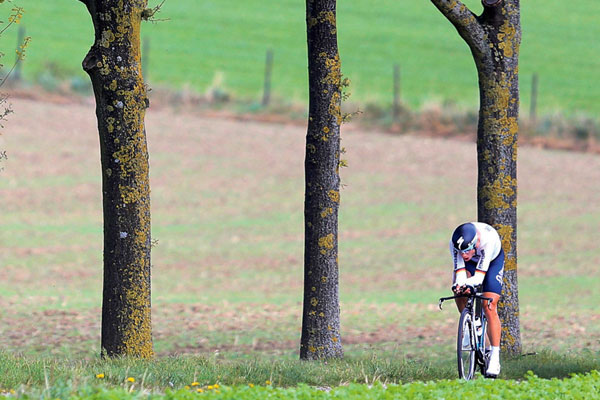Time trial performance: why even pacing might not be best

Previously in Cycling Weekly, we have reported on new research suggesting that in undulating/hilly terrain or in windy conditions, a variable power/effort pacing strategy might actually produce a faster time than trying to maintain a constant power/effort level.
The consensus among sports scientists, though, remains that in events lasting over four minutes and on flat courses in calm conditions, a uniform distribution of work remains the best option to maximise time trial performance.
But now a new study on 20km time trial pacing conducted by British scientists at the University of Northumbria has put another pacing cat among the time trial pigeons.
The science
In an elegantly designed study, 15 well-trained male cyclists undertook five separate 20km time trials on five separate occasions (A-E).
In the first three trials (A-C), the cyclists were asked to ride a simulated 20km time trial as fast as they could, i.e. by using a ‘self-paced' strategy. For each cyclist, the researchers noted which of these three trials was the fastest, and the average power output of this effort.
In the next two trials, the cyclists again rode a simulated 20km time trial, but this time followed two even-paced strategies:
The latest race content, interviews, features, reviews and expert buying guides, direct to your inbox!
In one even-paced trial (D), the cyclists were asked to cycle to exhaustion while sticking rigorously to a fixed pace/power output. This power output/pace throughout was exactly equivalent to the average obtained in their best self-paced performance time trial.
In the other even-paced trial (E), the cyclists were instructed to maintain the same overall target intensity as above for a distance of 20km, but the actual minute-to-minute intensity was free to vary depending on the effort and cadence of the cyclist.
During these trials, heart rates, levels of blood lactate and the cyclists' rate of perceived exertion (RPE) were all recorded.
In a nutshell
The results were surprising: in trial D - where the cyclists were asked to cycle to exhaustion while sticking rigorously to the average fixed pace/power output recorded in the best of their self-paced trials - nine out of the 15 cyclists were unable to reach the 20km mark because they became exhausted.
These nine cyclists only managed to complete 51-83 per cent (10.3-15.3km) of the work done in their self-paced trial. The failure as a result of this enforced even-pacing strategy was associated with a significantly faster rise in blood lactate (a measure of muscular fatigue).
By contrast, all the cyclists successfully completed trial E, which allowed small variations in power while maintaining the same overall average.
So what?
These results run contrary to conventional wisdom - that an even-paced strategy is best for fast times. The fact that nine cyclists couldn't even complete the rigorously enforced even-paced 20km, even though they were only asked to ride at the same average power output as they'd achieved in their best self-paced time trial, is remarkable.
It's likely that in the self-paced trial, a slight variation of pace was better at preventing lactate build-up the cyclists' muscles, compared to a completely constant power output.
Eur J Appl Physiol. 2013 Oct 2. [Epub ahead of print]
This article was first published in the November 7 issue of Cycling Weekly. Read Cycling Weekly magazine on the day of release where ever you are in the world International digital edition, UK digital edition. And if you like us, rate us!
Founded in 1891, Cycling Weekly and its team of expert journalists brings cyclists in-depth reviews, extensive coverage of both professional and domestic racing, as well as fitness advice and 'brew a cuppa and put your feet up' features. Cycling Weekly serves its audience across a range of platforms, from good old-fashioned print to online journalism, and video.